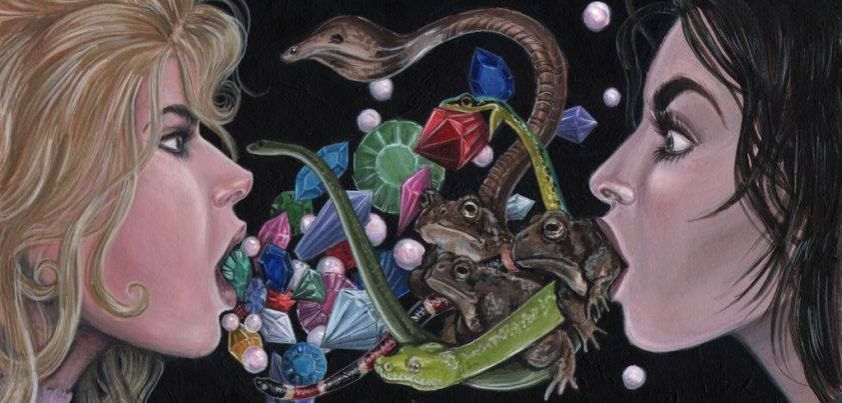 This story from Charles Perrault is about a bad-tempered, greedy widow and her two daughters. One girl is selfish, rude and ugly but loved by her mother. The other girl is kind, polite and beautiful but treated badly. With the help of a fairy (who else?), the kind daughter marries a prince and the selfish daughter dies alone. The story leaves readers wondering about the fairy’s gift. Life would be miserable (and maybe impossible) if something fell from your mouth every time you opened it? Also, did the prince really marry her out of love, or was it for diamonds?
This story from Charles Perrault is about a bad-tempered, greedy widow and her two daughters. One girl is selfish, rude and ugly but loved by her mother. The other girl is kind, polite and beautiful but treated badly. With the help of a fairy (who else?), the kind daughter marries a prince and the selfish daughter dies alone. The story leaves readers wondering about the fairy’s gift. Life would be miserable (and maybe impossible) if something fell from your mouth every time you opened it? Also, did the prince really marry her out of love, or was it for diamonds?
Our source for the story was The Blue Fairy Book, one of a series of twelve collections of folk and fairy tales for children edited by by Andrew Lang. This is the first book in the series, published in 1899. The book contains translations of seven Perrault stories. The original story appeared in Perrault’s Stories or Tales from Times Past, with Morals, also known as Tales of Mother Goose, published over 200 years earlier. The original title was The Fairies (Les Fées), and the morals provided by Perrault were:
Money and jewels still, we find,
Stamp strong impressions on the mind.
But sweet discourse more potent riches yields;
Of higher value is the pow’r it wields.
and
Civil behaviour costs indeed some pains,
Requires of complaisance some little share;
But soon or late its due reward it gains,
And meets it often when we’re not aware.
Perrault created many of his stories by re-writing traditional folktales. The source for a number of these, including Cinderella, Puss in Boots and Sleeping Beauty, is believed to be The Pentamerone, an Italian collection of folktales published in 1636. The source for Toads and Diamonds is generally believed to be the Pentamerone story The Two Cakes.
Toads and Diamonds Original Text / PDF (914 words)
The Two Cakes Original Text / PDF (2,522 words)
Phikul Thong: A Possible Asian Connection
We have commented before on how there are thousands of Folk and Fairy Tales around the world that follow similar plots to those of other cultures. In many cases there are enough differences to show that this has probably happened by chance. However, sometimes parts of stories are so similar as to make it appear as if one must have been taken from the other, or they both developed from a common earlier story. This is the case with Toads and Diamonds and one of the most famous Thai folktales, Phikul Thong.
Phikul Thong Original Text / PDF (730 words)
Our source for Phikul Thong was the book Fascinating Folktales of Thailand by Thanapol Chadchaidee. The two stories are so alike that it is hard to believe that one did not come from the other. An observant reader will see that the only major difference is that in Lang’s version of Toads and Diamonds the two girls are sisters, whereas in Phikul Thong the two girls are stepsisters. However, in the original French language version of the story the girls were also stepsisters. The story was changed when it was first published in English to make the girls less like those in Perrault’s Cinderella, which was to appear in the same book.
Perrault did not start writing children’s stories until in retirement. He was an important member of French society and well known to King Louis XIV at the time of the 1686 visit to France by the Siamese diplomat Ok Phra Wisut Sunthon, better known by the nickname Kosa Pan. Kosa Pan’s embassy was a great success and received a lot of attention in French society. One of Perrault’s official positions was secretary of the Académie des Inscriptions et Belles-Lettres. Among other things, this organization was concerned with the study of non-European languages and cultures. During Kosa Pan’s visit, there would have been a lot of discussion about differences between French and Siamese culture. It is highly likely that as part of this there could have been a sharing of traditions and beliefs, including folktales.